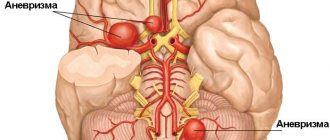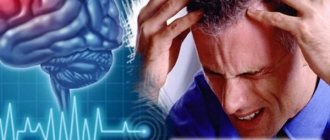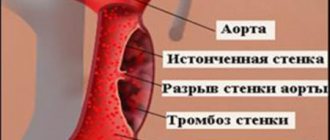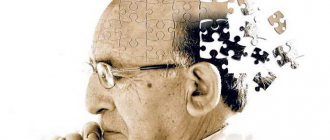© Author: A. Olesya Valerievna, candidate of medical sciences, practicing pathologist, teacher at a medical university, especially for SosudInfo.ru (about the authors)
Brain death means a complete and irreversible cessation of its vital activity, when the heart continues to beat and breathing is maintained through artificial ventilation (ALV).
Unfortunately, the number of patients who have irreversible events in the brain is large. Their treatment is carried out by resuscitation specialists, ensuring the maintenance of the main life support systems - breathing and circulation. From a medical and ethical point of view, it is always difficult to establish the fact of irreversibility of brain death, because this means declaring a person dead, although his heart continues to contract.
The brain lives after a person’s death for about five minutes, that is, after cardiac arrest, it is still able to maintain its activity for some time. During this period, it is very important to have time to carry out resuscitation, then there will be a chance for a full life. Otherwise, irreversible neuronal death will be fatal.
For relatives and friends, the issue of recognizing a sick relative as non-viable due to brain death is very difficult: many believe that a miracle will happen, others believe that doctors are not making enough efforts to “revive” the patient.
There are frequent cases of litigation and disputes when relatives consider the disconnection of the ventilator to be premature or erroneous. All these circumstances force us to objectify the data of symptoms, neurological and other types of examinations, so that an error is excluded, and the doctor who turned off the ventilator does not act as an executioner.
In Russia and most other countries, brain death is identified with the death of the whole organism, when maintaining the vital functions of other organs through medication and hardware treatment is impractical, which distinguishes brain death from a vegetative state and coma.
As already mentioned, under normal conditions, brain death occurs 5 minutes after breathing and heartbeat stop, but at low temperatures and various diseases this period can be lengthened or shortened. In addition, resuscitation measures and treatment can restore cardiac activity and provide ventilation of the lungs, but brain function cannot always be returned to its original state - comas, a vegetative state, or irreversible death of nervous tissue are possible, requiring different approaches from specialists.
Brain death established through clear criteria is the only reason when a doctor has the right to turn off all life support devices without the risk of being held legally liable. It is clear that such a formulation of the question requires compliance with all diagnostic algorithms for this condition, and an error is unacceptable.
Causes
Brain death can be caused by different reasons, but they trigger the development of the same pathological processes. Blood circulation is impaired, and this dysfunction is persistent. This provokes acute oxygen starvation, which causes metabolic products to stagnate in the tissues. Irreversible brain damage develops.
The main reasons are as follows:
- diseases, including inflammatory processes in brain tissue;
- injuries;
- circulatory disorders (hemorrhagic or ischemic stroke);
- multiple organ failure;
- poisoning (alcohol, lithium, drugs);
- tumor (cancer causes numerous tissue destructions);
- heart diseases, etc.
The phenomenon of vascular occlusion is extremely dangerous. At the same time, their patency is impaired, and oxygen starvation of the tissues occurs. Occlusion of arteries and veins that lead to the brain is especially dangerous. Often, pathological anatomy of the deceased reveals complete blockage of blood vessels. This can be a consequence of injury, disease and causes damage to neurons.
The brain stem may be damaged primarily or secondary. With a primary lesion, direct damage occurs (if there is a fracture of the base of the skull, the functions of the trunk itself are impaired). In case of secondary damage, the trunk suffers due to the resulting edema and dislocation syndrome. With swelling, the tissue begins to protrude strongly through the opening of the back of the head, due to which the trunk is excessively compressed, blood circulation stops and necrosis begins. This is why protecting the brain from swelling is so important.
All of the above reasons are considered extreme; they have an extremely negative effect on neurons. The brain stem and its cortex are primarily affected. The task of the trunk area is to maintain cardiac activity, breathing, control blood pressure, and the cortex is responsible for thought processes, consciousness, etc.
Cardiac arrest does not immediately lead to brain death, but everything happens very quickly. A person without blood circulation can live only a few minutes. 3 minutes without blood supply can lead to irreversible death of neurons, resulting in coma. If the cerebral cortex has died, vital functions will be lost and death can occur almost immediately.
The time that the body can survive without cardiac activity is influenced by a whole range of factors:
- age;
- general condition of the body;
- presence of diseases;
- the reason that caused this condition;
- ambient temperature, etc.
After just three minutes of oxygen starvation, neurons begin to die. This is an irreversible process, since dead tissue is not restored. In a healthy young person, brain death may slow down slightly. If the ambient temperature is low, the brain will die more slowly. If resuscitation is performed correctly at this time, the person can be brought back to life.
The consequences of circulatory arrest can be unpredictable. Sometimes a person wakes up from a coma, blood supply to the brain is restored, but it turns out that a significant part of the neurons have already died. If the brain dies, but the heart works, it will no longer be possible to return the victim to normal life. He can only exist, and is not even able to breathe on his own.
What Causes NDE Effects?
Awareness of one's own death
One of the most common experiences is the awareness of one's own death. However, this feeling has also been experienced by living people with Cotard's syndrome (walking corpse syndrome).
A striking example is the case of Attributional style in a case of Cotard delusion. A 24-year-old female patient in a London hospital. She believed that she had died of a cold and was in heaven. After a few days, the mania began to subside and then disappeared completely.
This syndrome is associated with dysfunction of the parietal lobe and prefrontal cortex of the brain. It is observed after head injuries, during the advanced stages of typhus and multiple sclerosis.
Light at the end of the tunnel
This experience is also often mentioned when describing near-death experiences. Living people experience similar sensations. During overload, pilots' blood pressure decreases greatly and hypotensive fainting may occur, which is accompanied by a temporary depression of Direct determination of man's blood pressure on the human centrifuge during positive acceleration. peripheral vision. For 5 to 8 seconds, pilots observe the same dark tunnel that humans experience during an NDE.
There is an assumption that the tunnel arises from Out-of-body experience and arousal. due to impaired blood supply to the retina. This state is characteristic of extreme fear and hypoxia, which, in principle, is close to dying.
Leaving the body
There is an assumption that the angular gyrus is responsible for this experience. In one experiment, Stimulating illusory own-body perceptions. found that stimulation of this area causes a sensation of transformation of the subjects' arms and legs (response of the somatosensory cortex) and movement of the entire body (response of the vestibular system).
Scientists have concluded that out-of-body experiences may occur due to distortion of information from the somatosensory cortex and vestibular system.
Also, out-of-body experiences are characteristic of the state on the border of sleep and wakefulness - hypnagogia and sleep paralysis. The body unbound: vestibular-motor hallucinations and out-of-body experiences. . In this state, a person may hallucinate, be conscious, unable to move, and experience a sensation of floating next to their body.
Happiness and Prosperity
Near-death experiences are typically accompanied by a state of euphoria and calm. The same effect can be obtained from taking certain medications, such as ketamine. This drug binds to mu opioid receptors and causes euphoria, dissociation, spiritual experiences and hallucinations.
Scientists theorize that during NDE, the opioid reward system is activated to dull pain, and the released endorphins create all the positive experiences.
There is also a theory that norepinephrine is to thank for the euphoria. There is nothing paranormal about near-death experiences: how neuroscience can explain seeing bright lights, meeting the dead, or being convinced you are one of them. and the locus coeruleus is the part of the brain responsible for the release of this hormone.
Norepinephrine is involved in a person’s arousal from fear, stress and hypercapnia - an excessive amount of CO2 in the blood, so it may well be released in a near-death state.
The locus coeruleus is associated with brain structures responsible for emotion (amygdala) and memory (hippocampus), fear response and opioid pain relief (periaqueductal gray matter), and dopamine reward system (ventral tegmental area). Scientists believe that the norepinephrine system may be associated with positive emotions, hallucinations and other effects of near-death experiences.
Whole life before your eyes
In the near-death state, people often see a series of events in their own lives. In his book “We are our brain. From the Uterus to Alzheimer's" Dick Swaab argues that people experience past events by activating the medial temporal lobe. This structure is involved in storing episodic autobiographical memories and is very sensitive to oxygen deprivation, so it is easy to activate.
The 2004 Britton Near-Death Experiences and the Temporal Lobe study confirmed that people who have experienced a near-death experience have changes in activity in the temporal lobe.
Meeting with the Dead
Many scientists believe that a person's near-death experience takes place in an intermediate state between sleep and wakefulness, and that the REM sleep phase is responsible for all mystical images and hallucinations.
To test this hypothesis, scientists studied Does the arousal system contribute to near death experience? 55 people who had near-death experiences. It turned out that these people were more susceptible to sleep paralysis and associated visual and auditory hallucinations. Scientists have suggested that when in danger, such people are more likely to enter REM sleep, which is why they have vivid memories of their near-death experiences.
In addition, hallucinations are common in some brain injuries. For example, patients with Alzheimer's disease or advanced Parkinson's disease sometimes report ghosts or monsters, and after brain surgery, some patients see dead relatives.
Symptoms
The following symptoms indicate brain death:
- there is no consciousness, and this process is persistent;
- there are no reactions to tingling, stroking, handling, no tactile sensitivity;
- no movement of the eyeballs;
- the heart has stopped, as evidenced by a straight line on the ECG;
- there is urinary and fecal incontinence;
- breathing is impaired, the chest does not rise.
Determining whether a patient has died is an extremely important task. Doctors do not immediately diagnose death. Even if all of the listed signs are detected, the person is monitored in the hospital for up to 12 hours. Sometimes, although rarely, signs of brain activity may appear. If during this time the patient does not react in any way, there are no trunk reflexes, then biological death can be stated.
It is important how the brain dies, what triggered the death of neurons. If poisoning has led to such serious consequences, the patient should be monitored for at least a day. If the cause is TBI, the observation time is reduced to 6 hours. The specific decision must be made by the neurosurgeon. It is important that the doctor monitors the patient from the onset of this condition, then he will have a complete picture of events that will allow him to make the right decision.
The onset of biological death is determined exclusively by a neurologist. It is based on subjective and objective criteria. If signs of brain death are clearly identified, the person must be disconnected from life support. This difficult decision is especially difficult to make if the disaster happened suddenly. Often relatives are literally horrified by such a message. If a person is sick for a long time, his loved ones eventually become at least a little accustomed to the idea that their loved one will be gone. In any case, this decision is very difficult.
Diagnostics
When diagnosing, the doctor must collect anamnesis. He must find out how long ago the patient fell into such a dangerous state, under what conditions he lost consciousness, and whether he had speech or motor activity. It is important to know what event preceded the loss of consciousness. An examination is carried out by a neurologist, he necessarily assesses the patient’s level of consciousness and checks his reflexes.
It is extremely important that the doctor excludes all those factors that can cause simulated brain death. It is sometimes caused by severe poisoning, including drugs. For this reason, a toxicological analysis is prescribed. It will help detect toxins or drugs that mimic the appearance of death.
Body temperature must be measured. If the temperature is below 32.2°C, it may distort the picture and show a false death. In this case, the person may be alive, but tests will show the opposite, since physiological processes literally freeze from the cold.
A blood test is prescribed that will help determine whether the metabolism is disturbed, whether there is hormonal dysfunction, and at what level the glucose levels are.
To correctly diagnose brain death, inpatients resort to instrumental research:
- encephalogram (EEG);
- contrast study of cerebral vessels;
- test with irritation of the eardrums (ice water is dripped onto them through the ear canal);
- apneic oxygenation test.
Oxygen starvation is extremely destructive for neurons, even if it is not long-term. Literally after a few minutes of complete lack of oxygen supply, tissues begin to die. The electroencephalogram in this case will show a zero line. This means that there is no brain activity at all.
Encephalography examines brain activity. In this case, the device registers biocurrents, their work is reproduced on paper in the form of curves.
The diagnostic protocol also includes the study of cerebral vessels using a contrast agent. It cannot always be accomplished, as there may be financial restrictions, and sometimes there is simply no equipment. The essence of the test is that a contrast agent is injected, which enters the brain vessels through the bloodstream and identifies possible areas of necrosis. If the brain is dead, the substance does not enter its vessels. This is one hundred percent confirmation of death.
Apneic oxygenation involves temporarily removing the patient from a ventilator. The goal is to observe whether spontaneous respiratory movements have appeared. The monitor monitors the level of carbon dioxide in the blood. It is carbon dioxide that stimulates the body to produce breathing movements. If after 8-10 minutes breathing does not appear, and the level of CO2 in the blood jumps by 20 mm Hg. Art. higher than the original, we can definitely talk about death.
If the body is accidentally discovered
If an ambulance team finds a victim without signs of life, doctors have no information how long he remains in this condition. In the absence of cadaveric spots, doctors cannot confirm in the field that biological death has occurred. In this case, resuscitation is mandatory.
Resuscitation measures include artificial ventilation of the lungs and closed heart massage. If there is bleeding, it is important to stop it so the victim does not bleed out. Damage to a large artery or head is extremely dangerous. If resuscitation measures are carried out correctly, a person can be brought back to life.
How to tell your family
Recently, it has become common to resort to the help of a psychologist in such cases. It will help family members come to terms with their loss.
Making a decision to disconnect a patient from life support is extremely difficult even for experienced doctors. Relatives are always unprepared for such a tragic development of events, so they literally lose their minds. Relatives tend to believe that they can still try to do something. They are often asked to wait at least a few days. If there is accurate evidence of brain death, the doctor must find the right words to explain the current situation to the relatives.
According to the rules of bioethics, if brain death is definitely established, the patient should be disconnected from devices that support life processes. There is no point in expecting him to come back to life if all tests have confirmed the absence of neuronal activity. This will be a humane decision.
Relatives should definitely ask what diagnostic research methods were used. The doctor must show a document confirming the established brain death. Only relatives have the right to decide to disconnect the victim from life-sustaining devices. The doctor’s task is not to succumb to emotions, but to make the right decision based on the specific results of the patient’s examination.
It is important to exclude the human factor and rely only on test results.
How long to keep the victim on life support is decided individually in each case. After a person is disconnected from the devices, Lazarus syndrome may occur. It consists in the fact that the deceased experiences individual muscle twitches. The head may turn involuntarily, the person may bend an arm or leg. It even happens that an already dead person arches. This is the result of contraction of the back muscles. It is important that the doctor warns the patient’s relatives in advance that such manifestations are possible. This does not mean that the victim comes to life.
Consequences
Brain death does not always lead to biological death. Sometimes medical intervention can save a life, if such a condition can be called that. In fact, after brain death, only certain vital functions can be maintained. The consequences of total neuronal death are terrible, this is complete dementia. Any vital indicator is so low that the body cannot cope without the support of devices. Such people are no longer able to continue living a full life. They live like plants and can die at any moment.
Even in order to maintain basic vital functions, continuous administration of medications will be required. Without medical equipment, the patient will not be able to breathe, and his heart will not be able to beat.
In the medical literature there are several descriptions of a case of a person returning to life after death. There is some confusion here. Most likely, such patients “resurrected” after clinical death, rather than biological death. This happens quite often. Clinical death can occur with serious damage, and with proper care, body functions are restored.
Even clinical death is not identical to brain death. It is the death of neurons that leads to the most tragic consequences.
Plan:
Introduction
- 1 Criteria for brain death 1.1 A set of clinical criteria, the presence of which is mandatory for establishing a diagnosis of brain death in the Russian Federation [1] 1.2 Recommendations of the Commission under the President of the United States 1.3 Necessary criteria for determining brain death
2 Clinical confirmatory studies
- 2.1 Cerebral angiography 2.2 Electroencephalography-EEG 2.3 Cerebral radioisotope angiography-Cerebral Radionuclid Angiogram-CRAG
3 Brain death and religion
- 3.1 Brain death in Christianity 3.2 Brain death in Islam 3.3 Brain death in Judaism
Notes
Reanimation
The consequences of brain death are irreversible. Just because a person is unconscious does not mean that he needs to perform resuscitation measures (ventilation, cardiac massage).
Cardiac massage is strictly contraindicated if the victim’s heart is beating, even abnormally. In this case, massage can, on the contrary, interfere with the correct contraction of the heart muscles.
Mouth-to-mouth or mouth-to-nose breathing, as well as chest compressions, are performed only if there is no heartbeat. Such events can save a person's life. If you ensure the supply of oxygen to the body and improve blood circulation, irreversible necrotic changes will not occur. Body functions can be completely restored.
If a pregnant woman is injured, it is important to monitor not only her vital signs, but also the condition of the fetus. The patient must be taken to the hospital as quickly as possible, since the child may die due to injury and stress.
It is extremely important to thoroughly master resuscitation techniques. Any of us can master them and, if necessary, save a person’s life.
Notes
Order of the Ministry of Health of the Russian Federation No. 460 of 01.01.2001 On approval of instructions for ascertaining the death of a person based on a diagnosis of brain death - zakon. *****/doc/mz/3_3_114.html The Vatican explained what should be understood by “death” - www. *****/text/319662/index. html Apologetics - *****/dictionary/01/apologetika_2_3-all. shtml Fundamentals of the social concept of the Russian Orthodox Church - www. *****/db/text/141422.html ^ 1 2
Views of the world's major religions on end-of-life decisions in the intensive care unit - www. *****/actual/etica/religion. htm Encyclopedia of Jewish Medical Ethics, MD Avraham Steinberg - www. /Encyclopedia-Jewish-Medical-Avraham-Steinberg/dp/ “Defining the moment of death,” a collection of articles in Hebrew from the Assia magazine at the Institute of Medical Ethics at Shaare Zedek Hospital - www. medetics. org. il/siteEng/Books. asp#44 Jewish Medical Ethics series (2 volumes) ditors: Rabbi Mordechai Halperin, MD, Prof. Shimon Glick, MD, and Rabbi David Fink, PhD, Determining the Moment of Death - www. medetics. org. il/siteEng/BooksEn. asp#53 “Tzitz Eliezer”, b. E. Waldenberg “Minhat Yitzchak”, R. Yitzchak Yaakov Weiss The main proponent of this idea was R. R.'s opinion Moshe Feinstein in Igrot Moshe, revealed by the author's son-in-law R. Moshe David Tendler.
Forecasts
Clinical death does not always mean that the patient will definitely die. Sometimes doctors manage to bring a person out of a state of clinical death. The prognosis will be influenced by what circumstance led to such a condition and what resuscitation measures were taken. The main condition is to restore blood circulation in the first 3-5 minutes. Sometimes resuscitation is carried out for up to 20-40 minutes.
Even if partial extinction and death of neurons has occurred, the functions of the medulla can be restored. If biological death or brain death is established, it is impossible to bring the patient back to life, you need to come to terms with this.
The peculiarity of the human brain is that it strives to preserve its functions by any means. If some neurons die, their tasks can be redistributed to other zones. Patients who have suffered a stroke, ischemia, and even serious TBI often return to a full life.
Is it possible to live without a brain?
Life and death are states that continuously follow each other. Complete brain death means the onset of a chronic vegetative state - the kind that is popularly called “vegetable” or life on machines. Outwardly, a person may not change in any way, but everything that was human in him - thoughts, character, living speech, sympathy, knowledge and memory - is lost forever. In fact, the prolongation of the vegetative state depends on the voltage in the electrical network. As soon as the devices stop working, the vegetative existence of a brain-dead person also ends.
The cause of brain destruction is very important; without clarification, it is impossible to declare death. This could be trauma, hemorrhagic stroke, dropsy or deep cerebral edema, poisoning incompatible with life and other undoubted conditions. In all cases where there is even the slightest doubt about the cause of brain death, the person’s condition is considered comatose and continued resuscitation measures are required.











